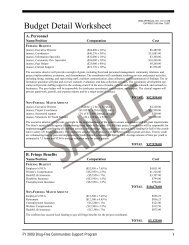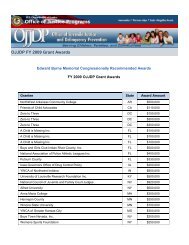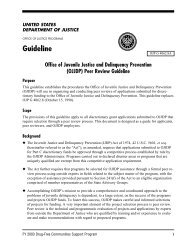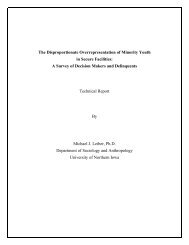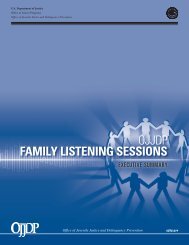Juvenile Court Statistics 2005. - Office of Juvenile Justice and ...
Juvenile Court Statistics 2005. - Office of Juvenile Justice and ...
Juvenile Court Statistics 2005. - Office of Juvenile Justice and ...
- No tags were found...
Create successful ePaper yourself
Turn your PDF publications into a flip-book with our unique Google optimized e-Paper software.
Chapter 1: Introductionthe disposition <strong>of</strong> a case (e.g., temporaryholding <strong>of</strong> a juvenile in a detentionfacility while awaiting courtorderedplacement elsewhere).Data Quality<strong>Juvenile</strong> <strong>Court</strong> <strong>Statistics</strong> relies on thesecondary analysis <strong>of</strong> data originallycompiled by juvenile courts or juvenilejustice agencies to meet theirown information <strong>and</strong> reporting needs.Although these incoming data filesare not uniform across jurisdictions,they are likely to be more detailed<strong>and</strong> accurate than data files compiledby local jurisdictions merely complyingwith a m<strong>and</strong>ated national reportingprogram.The heterogeneity <strong>of</strong> the contributeddata files greatly increases the complexity<strong>of</strong> the Archive’s data processingtasks. Contributing jurisdictionscollect <strong>and</strong> report information usingtheir own definitions <strong>and</strong> coding categories.Therefore, the detail reportedin some data sets is not contained inothers. Even when similar data elementsare used, they may have inconsistentdefinitions or overlappingcoding categories. The Archive restructurescontributed data into st<strong>and</strong>ardizedcoding categories in orderto combine information from multiplesources. The st<strong>and</strong>ardization processrequires an intimate underst<strong>and</strong>ing <strong>of</strong>the development, structure, <strong>and</strong> content<strong>of</strong> each data set received. Codebooks<strong>and</strong> operation manuals arestudied, data providers interviewed,<strong>and</strong> data files analyzed to maximizethe underst<strong>and</strong>ing <strong>of</strong> each informationsystem. Every attempt is made toensure that only compatible informationfrom the various data sets isused in the st<strong>and</strong>ardized data files.While the heterogeneity <strong>of</strong> the dataadds complexity to the development<strong>of</strong> a national data file, it has proven tobe valuable in other ways. The diversity<strong>of</strong> the data stored in the National<strong>Juvenile</strong> <strong>Court</strong> Data Archive enablesthe data to support a wider range <strong>of</strong>research efforts than would a uniform,<strong>and</strong> probably more general,data collection form. For example, theFederal Bureau <strong>of</strong> Investigation’s(FBI’s) Uniform Crime Reporting(UCR) Program is limited by necessityto a small number <strong>of</strong> relativelybroad <strong>of</strong>fense codes. The UCR <strong>of</strong>fensecode for larceny-theft combinesshoplifting with a number <strong>of</strong> otherlarcenies. Thus, the data are uselessfor studies <strong>of</strong> shoplifting. In comparison,many <strong>of</strong> the Archive’s data setsare sufficiently detailed to enable aresearcher to distinguish <strong>of</strong>fensesthat are <strong>of</strong>ten combined in otherreporting series—shoplifting can bedistinguished from other larcenies,joyriding from motor vehicle theft,<strong>and</strong> armed robbery from unarmedrobbery. The diversity <strong>of</strong> these codingstructures allows researchers toconstruct data sets that contain thedetail dem<strong>and</strong>ed by their researchdesigns.Validity <strong>of</strong> the EstimatesThe national delinquency <strong>and</strong> status<strong>of</strong>fense estimates presented in thisReport were generated with datafrom a large nonprobability sample <strong>of</strong>juvenile courts. Therefore, statisticalconfidence in the estimates cannot bemathematically determined. Althoughstatistical confidence would be greaterif a probability sampling designwere used, the cost <strong>of</strong> such an efforthas long been considered prohibitive.Secondary analysis <strong>of</strong> available datais the best practical alternative fordeveloping an underst<strong>and</strong>ing <strong>of</strong> theNation’s juvenile courts.National estimates <strong>of</strong> delinquencycases for 2005 are based on analyses<strong>of</strong> individual case records from 2,000courts <strong>and</strong> aggregate court-level dataon cases from more than 150additional courts. Together, thesecourts had jurisdiction over 80% <strong>of</strong>the U.S. juvenile population in <strong>2005.</strong>National estimates <strong>of</strong> petitioned status<strong>of</strong>fense cases for 2005 are basedon case records from nearly 2,000courts <strong>and</strong> court-level data frommore than 200 additional courts, covering77% <strong>of</strong> the juvenile population.The imputation <strong>and</strong> weighting proceduresthat generate national estimatesfrom these samples control formany factors: the size <strong>of</strong> a community,the age <strong>and</strong> race composition <strong>of</strong>its juvenile population, the volume <strong>of</strong>cases referred to the reportingcourts, the age <strong>and</strong> race <strong>of</strong> the juvenilesinvolved, the <strong>of</strong>fense characteristics<strong>of</strong> the cases, the courts’ responsesto the cases (manner <strong>of</strong>h<strong>and</strong>ling, detention, adjudication, <strong>and</strong>disposition), <strong>and</strong> the nature <strong>of</strong> eachcourt’s jurisdictional responsibilities(i.e., upper age <strong>of</strong> originaljurisdiction).Structure <strong>of</strong> the ReportChapters 2 <strong>and</strong> 3 <strong>of</strong> this Report presentnational estimates <strong>of</strong> delinquencycases h<strong>and</strong>led by the juvenile courtsin 2005 <strong>and</strong> analyze caseload trendssince 1985. Chapter 2 describes thevolume <strong>and</strong> rate <strong>of</strong> delinquencycases, demographic characteristics <strong>of</strong>the juveniles involved (age, gender,<strong>and</strong> race), <strong>and</strong> <strong>of</strong>fenses charged.Chapter 3 traces the flow <strong>of</strong> delinquencycases from referral to courtthrough court processing, examiningeach decision point (i.e., detention,intake decision, adjudicationdecision, <strong>and</strong> judicial disposition)<strong>and</strong> presenting data by demographiccharacteristics <strong>and</strong> <strong>of</strong>fense. Together,these two chapters provide a detailednational portrait <strong>of</strong> delinquencycases.Chapter 4 presents national estimates<strong>of</strong> status <strong>of</strong>fense cases formally h<strong>and</strong>ledby the juvenile courts in 2005<strong>and</strong> caseload trends since 1995. Itincludes data on demographic characteristics,<strong>of</strong>fenses charged, <strong>and</strong> caseprocessing.Appendix A describes the statisticalprocedure used to generate these estimates.Readers are encouraged to<strong>Juvenile</strong> <strong>Court</strong> <strong>Statistics</strong> 2005 3


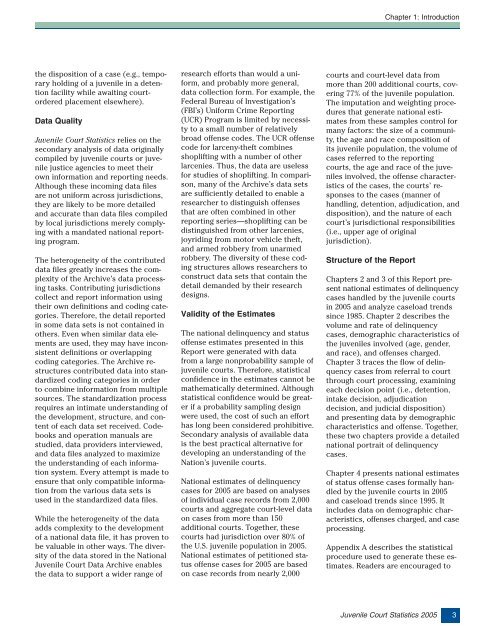
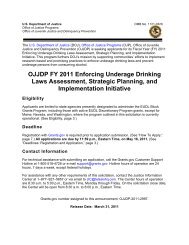
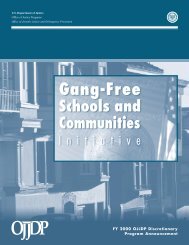
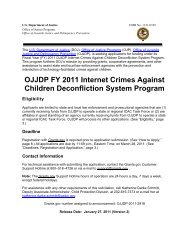
![Chapter 5 [PDF] - Office of Juvenile Justice and Delinquency ...](https://img.yumpu.com/46584340/1/190x245/chapter-5-pdf-office-of-juvenile-justice-and-delinquency-.jpg?quality=85)
